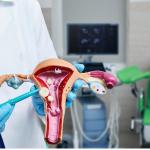
Many women worry about whether uterine fibroids can increase their cancer risk, and with so much information available, separating fact from fear is important.
This blog explores fibroids and cancer risk, debunks common myths, and highlights the importance of monitoring fibroid-related symptoms to make informed health decisions. If you’re concerned you might have fibroids and are experiencing abnormal menstrual symptoms, schedule a consultation today.
Differentiating Cancerous Growths vs. Fibroids
Differentiating between fibroids and cancerous growths requires imaging techniques like ultrasound and MRI. Uterine fibroids usually appear as well-defined, round masses with smooth borders. These noncancerous growths can be managed with a range of treatment options, from minimally invasive procedures to surgery, depending on their size and symptoms.
Masses with irregular edges may require further evaluation using multiple imaging methods and a biopsy is often necessary for a definitive diagnosis as symptoms alone are not always conclusive. Routine diagnostic procedures, including pelvic exams, help monitor uterine growths and detect abnormalities early.
Do Fibroids Increase the Risk of Other Cancers?
Research on fibroids and cancer risk is ongoing, but current evidence suggests that there is no connection between uterine fibroids causing or increasing cancer risk. However, certain risk factors for fibroids, such as hormonal imbalances or genetic predisposition, may impact the development of other conditions.
Do Fibroids Put You at Risk for Uterine Cancer?
Fibroids do not directly increase the risk of uterine cancer. However, they may make it more difficult to detect early warning signs. A primary symptom of uterine cancer is abnormal bleeding, which is also a common fibroid symptom. Since fibroids may cause heavy or irregular periods, they can delay the recognition of cancer-related symptoms.
Do Fibroids Increase the Risk of Ovarian Cancer?
There is no proven direct link between fibroids and ovarian cancer, as fibroids primarily affect the uterus, while ovarian cancer grows in the ovaries. Both conditions can cause symptoms like persistent pelvic pain, bloating, or pressure in the lower abdomen, so regular screenings and early evaluation of unusual symptoms can help with detection, especially with ovarian cancer, which often goes undetected until later stages.
Do Fibroids Increase Breast Cancer Risk?
While hormonal factors, particularly estrogen, influence the development of both fibroids and breast cancer, there is no evidence that fibroids increase the risk of breast cancer. Breast cancer arises from abnormal cell growth in breast tissue, and despite their link to hormone fluctuations, they develop independently.
While fibroid growth and cancer risk are not correlated, symptoms like heavy bleeding or pelvic pain shouldn’t be ignored. Consult a specialist at USA Fibroid Centers for an evaluation.
CALL 855.615.2555 TO MEET WITH A SPECIALIST
How to Recognize Concerning Symptoms

Knowing when fibroid symptoms may indicate a more serious issue and require medical attention is important. Specific signs warrant further evaluation to rule out potential complications, including rare cancer cases.
Fibroid Symptoms vs. Cancer Symptoms
Fibroids and uterine sarcoma share similar symptoms, as both conditions can enlarge the uterus, cause a noticeable mass in the pelvis, and pressure nearby organs.
These similar symptoms include:
- Heavy or prolonged menstruation
- Anemia leading to fatigue and iron deficiency
- Pain during intercourse
- Frequent urination or difficulty emptying the bladder
- Chronic constipation or bloating
- Pelvic or lower back pain
- Increased menstrual cramping
- Abdominal swelling
The overlapping symptoms with uterine sarcoma can make a diagnosis more difficult. The following signs may indicate that the growths are not just fibroid tumors but rather a cancer risk:
- Rapid fibroid growth causing acute pelvic or abdominal pain
- Post-menopausal bleeding
- Severe anemia from excessive bleeding, leading to fatigue
- Unusual findings in imaging or blood tests
Routine check-ups, including regular pelvic exams and imaging when needed, can help detect conditions like fibroids and cancer, leading to timely treatment.
Factors That Can Increase Risk of Developing Cancerous Uterine Growths
While fibroids are almost always noncancerous, certain factors can raise the risk of uterine sarcoma (a rare cancer that forms in the muscles of the uterus). Although its exact cause is unknown, research has identified several risk factors, such as:
- Age: Risk increases with age, particularly in women over 50.
- Hormonal Imbalances: Elevated estrogen levels can contribute to fibroid growth, though they do not directly cause cancer.
- Previous Cancer Treatment: Radiation therapy in the pelvic area, radiation treatment for other cancers, and Tamoxifen use for five or more years to prevent and treat breast cancer.
- Family History: A family history of uterine cancer or related conditions, such as renal cell carcinoma syndrome.
While these factors increase the risk of a cancer diagnosis, they do not mean that a person will develop cancer. Regular check-ups and doctor’s visits can help differentiate between fibroids and cancer risk early. If you’re concerned about fibroid tumors, schedule a diagnostic appointment with a fibroid specialist at USA Fibroid Centers today.
How Are Cancerous Uterine Growths Diagnosed?

Doctors use several diagnostic methods to differentiate between fibroids and cancer, such as:
- Imaging: Ultrasounds are often the first step in determining the size, shape, and location of uterine growths, while MRI provides more detailed visualization.
- Biopsy: Abnormalities found in imaging tests can be analyzed with a biopsy using a tissue sample to confirm the presence of cancer.
- Blood Tests: Certain blood markers may indicate cancer.
Proper diagnostic testing ensures conditions are detected early for timely treatment.
Treatment for Fibroids and Uterine Cancer Concerns
Uterine fibroid embolization (UFE) is a minimally invasive procedure that shrinks fibroids and relieves discomfort for women experiencing fibroid-related symptoms. While UFE is effective for benign fibroids, it is not for treating cancerous uterine growths. Early diagnosis is crucial for appropriate treatment, whether for fibroids or uterine sarcoma.
Explore UFE treatment at USA Fibroid Centers by scheduling online today or finding a fibroid treatment center near you.
FAQs
Are Specific Types of Fibroids More Likely to be Cancerous?
Fibroids are almost always benign, regardless of their type. These non-cancerous growths develop from the muscle tissue of the uterus and are the most common pelvic tumors in women. While the location of different fibroid types may influence symptoms or fertility, there is no correlation between uterine fibroids and increased cancer risk.
Can Fibroids Cause Abnormal Test Results for Cancer Screening?
Although no current research connects cancer risk and fibroids, fibroids can lead to abnormal results on specific cancer screening tests, like non-invasive prenatal testing (NIPT). These false-positive results occur because fibroids can release abnormal DNA fragments into the bloodstream, especially when large or numerous. However, most women with fibroids do not experience abnormal cancer screenings, and they typically do not affect other screening methods like Pap smears or biopsies.
Is Rapid Fibroid Growth Always a Sign of Cancer?
While fibroids can sometimes grow quickly and become large, their size or growth rate does not indicate malignancy, nor do they increase the risk of developing cancer. However, if you notice symptoms that indicate rapid growth of fibroids, it’s best to schedule a consultation with a fibroid specialist.



